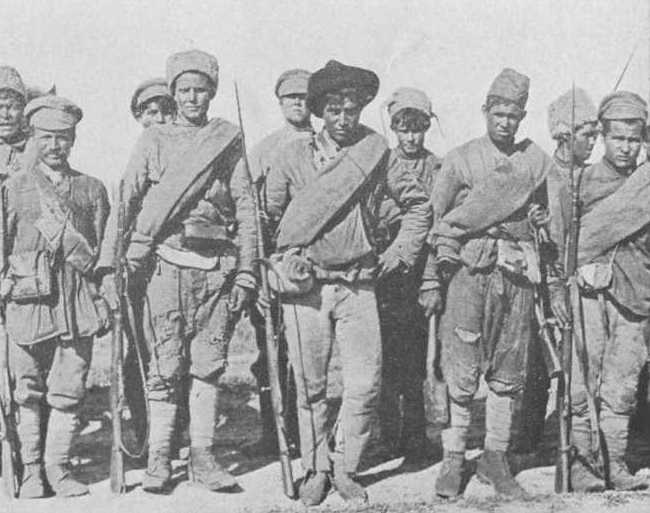
The Figures I Used
The figures I used for the Whites, including Cossacks
The figures I used for the Reds
The figures I used for the Freikorps, Poles and Estonian Nationalists
And just for good measure a few pictures
Why 15mm?

Red Guard using Peter Pig figures
My preferences are to game the southern theatre of the Russian Civil War, the Baltic campaigns and the 1920 Polish-Soviet War, all of which mainly consisted of battles of movement. Hence I felt that the smallest scale figures possible were in order.
I really would have preferred 10mm, but no-one made them them when I started looking (though it is quite achievable as a scale now). I seriously considered 6mm, but was worried about persuading other people to play them, so lacking is the visual appeal in khaki figures in that size. Which left 15mm as the smallest scale where you can tell the uniforms apart and yet the vehicles (and particularly the trains) don't dwarf the table.
There are some wonderful models in 20mm and 25mm, but for me they are only suitable if I was interested in the less expansive battles of the northern theatres (Yudenich, Murmansk, perhaps the Baltic). There was also no way I could realistically expect to collect and paint the number of different units I wanted in those scales.
Why Peter Pig?
Having selected 15mm the only option for me was Peter Pig. They have almost the entire range required for the Russian Civil War (other than some vehicles) at a reasonable price. Very few poses are "duds" and the animation is excellent. I have found their customer service to be really excellent and they will mix up poses from their packs if asked (admittedly you pay a bit extra).
I just don't like the style of most Minifigs figures, although there are exceptions. While they are OK in their own way, I generally find them wooden when put against more active poses, and I prefer my units to have as many varied poses as possible.
My one brush with Irregular Miniatures has left me permanently scarred. Perhaps I got a dud bunch, but goodness me they were very average sculpts and atrociously bad casts. I ended up giving away almost all the ones I bought. I did get my heavy guns via them though.
I really prefer my units to be in advancing poses, and fortunately most PP packs are. I have noted where a pack differs from this.
Not everyone likes the style of the PP horses, which are quite small, but I rationalise this as representing Cossack nags, the best horseflesh having been used up in the Great War. More of a concern to me was the lack of variety of horse poses because all the RCW packs come with the same two basic horses. I got round this by asking PP to give me horses from other packs, and especially 16-4 German Uhlans, though also some 16-18 French Dragoons(a trifle donkey-like) and 16-30 German cavalry with Pickelhaube. (I tried to avoid the horses that come as standard with the British cavalry packs, as these have their carbines and scabbards attached to the horses.)
Why so varied?
The concept of "uniform" in the Pygmy Wars should be applied rather loosely. Men frequently fought in civilian clothes, supplies looted from the enemy or some favoured non-regulation item (such as black leather coats). Consequently I have gone for a very varied approach but nowhere near as varied as the real thing: for example, this is apparently one of Kolchak's better units.

Even the best White units in the south, who cared about uniforms more than the rest, never managed to get any real uniformity. The only time a unit might look entirely regular is when it had been recently withdrawn and re-equipped, especially if using ex-Allied material. (The pictures of such units in pristine white or black blouses and all in coloured caps invariably date to the period after the war, in the Gallipoli internment.)
